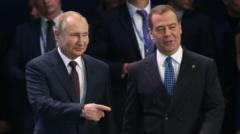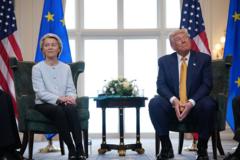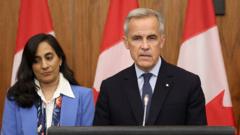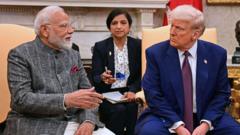Despite months of negotiations following a self-imposed deadline, a new trade agreement between the US and Canada remains elusive, escalating concerns over economic impacts on both sides.
**US-Canada Trade Talks Stall Amid Increasing Tensions**
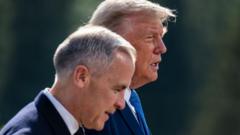
**US-Canada Trade Talks Stall Amid Increasing Tensions**
As US-Canada trade negotiations reach an impasse, both nations confront the economic fallout of stalled discussions and escalating tariffs.
In recent developments, a self-imposed deadline for a renewed US-Canada trade agreement has passed without resolution, leaving both nations to assess their next steps amidst an ongoing tariff conflict. Six months of negotiations have yielded little progress, with both US President Donald Trump and Canadian Prime Minister Mark Carney expressing skepticism about the feasibility of a swift resolution.
This shift in tone contrasts sharply with the optimistic atmosphere of the G7 summit earlier this summer, where both leaders had expressed intentions to work towards a resolution by the end of the season. Trump's recent criticisms of Canada’s recognition of Palestinian statehood further complicated the talks, reflecting deeper geopolitical rifts that are impacting economic discussions.
Professor Fen Hampson from Carleton University highlights a developing sentiment among Canadian negotiators that prioritizing the quality of an agreement over rushing to meet deadlines may be more beneficial. However, mounting pressure from Canadian conservatives and businesses emphasizes the necessity for a reprieve from current tariff rates, which have reached as high as 35%. The imposition of American tariffs on various goods, justified by the US as a response to Canada's failure to curb illegal drug trade, continues to strain economic relations.
Despite the challenges, Hampson notes that Canada benefits from the Canada–United States–Mexico Agreement (CUSMA), which allows for approximately 90% of Canadian exports to enter the US without tariffs if compliance paperwork is filed correctly. This agreement provides Canada with a crucial buffer compared to countries facing higher tariff rates from the US.
The Canadian government has also introduced $60 billion in counter-tariffs on American imports and is exploring economic relief for affected sectors. Concurrently, it has ramped up defense spending and enhanced border security to align with US expectations, while also battling the imposition of Trump’s tariffs that directly affect key industries such as automotive manufacturing.
Experts suggest that rising consumer dissatisfaction in the US due to these tariffs may provoke pressure on American leaders to pursue negotiations more actively. The prospective pain for American businesses, particularly from smaller firms, could ultimately shift the political dynamics in favor of resolving trade issues.
As negotiations continue, Canadian wholesalers are gearing up for potential long-term shifts in sourcing and sales strategies, resulting in contingency planning and enhanced efforts to diversify trade relations. Amid these tensions, trade experts advocate for a gradual approach to negotiations, wary of the repercussions of aggressive retaliatory measures.
While the economic linkages between Canada and the US remain robust, the current landscape of trade negotiations suggests a pivotal moment for both countries as they navigate the fallout of heightened tariffs and strive for a more stable economic future. Recognizing the necessity for internal restructuring might indeed prompt Canada to bolster its economic resilience going forward.
This shift in tone contrasts sharply with the optimistic atmosphere of the G7 summit earlier this summer, where both leaders had expressed intentions to work towards a resolution by the end of the season. Trump's recent criticisms of Canada’s recognition of Palestinian statehood further complicated the talks, reflecting deeper geopolitical rifts that are impacting economic discussions.
Professor Fen Hampson from Carleton University highlights a developing sentiment among Canadian negotiators that prioritizing the quality of an agreement over rushing to meet deadlines may be more beneficial. However, mounting pressure from Canadian conservatives and businesses emphasizes the necessity for a reprieve from current tariff rates, which have reached as high as 35%. The imposition of American tariffs on various goods, justified by the US as a response to Canada's failure to curb illegal drug trade, continues to strain economic relations.
Despite the challenges, Hampson notes that Canada benefits from the Canada–United States–Mexico Agreement (CUSMA), which allows for approximately 90% of Canadian exports to enter the US without tariffs if compliance paperwork is filed correctly. This agreement provides Canada with a crucial buffer compared to countries facing higher tariff rates from the US.
The Canadian government has also introduced $60 billion in counter-tariffs on American imports and is exploring economic relief for affected sectors. Concurrently, it has ramped up defense spending and enhanced border security to align with US expectations, while also battling the imposition of Trump’s tariffs that directly affect key industries such as automotive manufacturing.
Experts suggest that rising consumer dissatisfaction in the US due to these tariffs may provoke pressure on American leaders to pursue negotiations more actively. The prospective pain for American businesses, particularly from smaller firms, could ultimately shift the political dynamics in favor of resolving trade issues.
As negotiations continue, Canadian wholesalers are gearing up for potential long-term shifts in sourcing and sales strategies, resulting in contingency planning and enhanced efforts to diversify trade relations. Amid these tensions, trade experts advocate for a gradual approach to negotiations, wary of the repercussions of aggressive retaliatory measures.
While the economic linkages between Canada and the US remain robust, the current landscape of trade negotiations suggests a pivotal moment for both countries as they navigate the fallout of heightened tariffs and strive for a more stable economic future. Recognizing the necessity for internal restructuring might indeed prompt Canada to bolster its economic resilience going forward.

